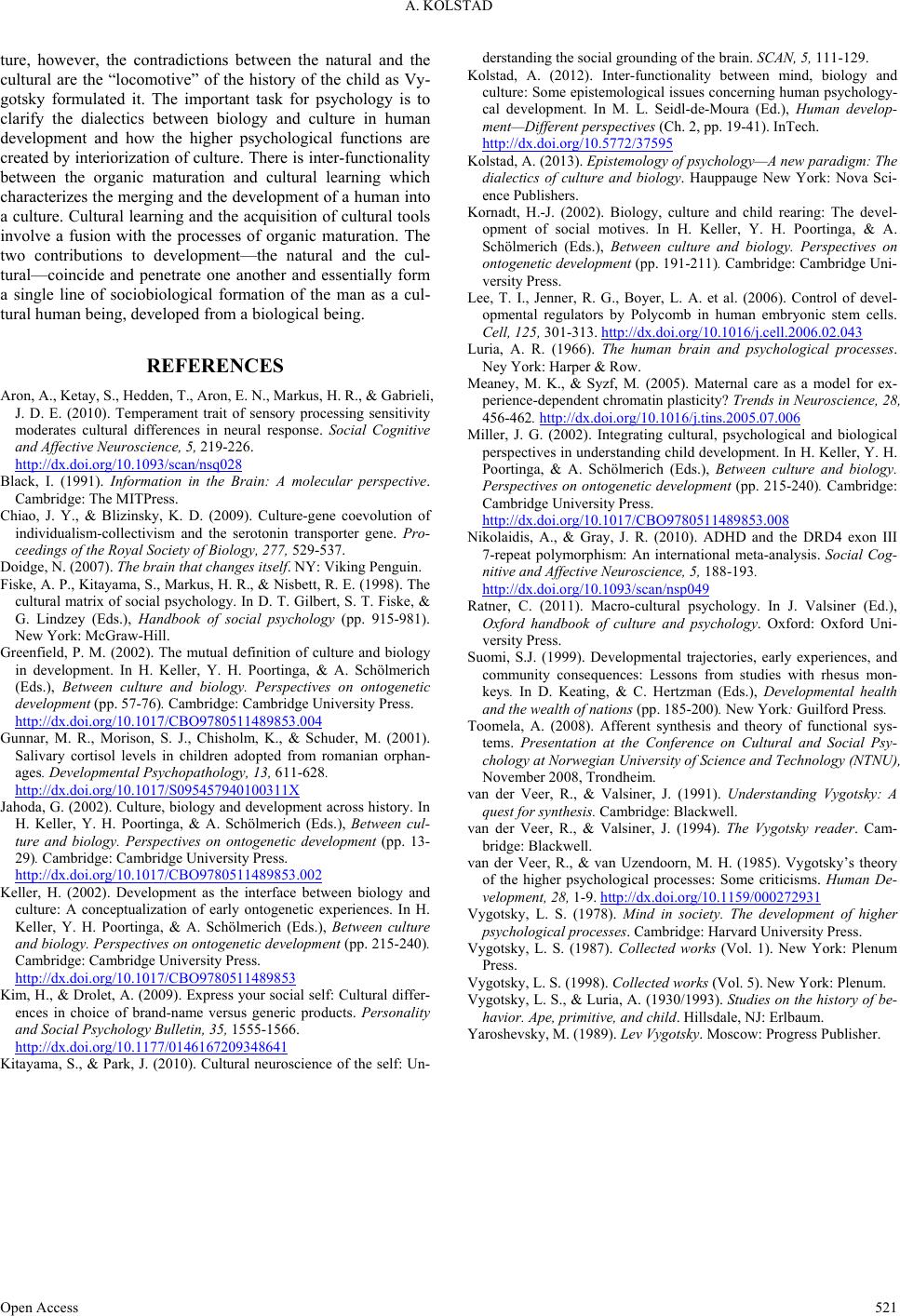
A. KOLSTAD
Open Access 521
ture, however, the contradictions between the natural and the
cultural are the “locomotive” of the history of the child as Vy-
gotsky formulated it. The important task for psychology is to
clarify the dialectics between biology and culture in human
development and how the higher psychological functions are
created by interiorization of culture. There is inter-functionality
between the organic maturation and cultural learning which
characterizes the merging and the development of a human into
a culture. Cultural learning and the acquisition of cultural tools
involve a fusion with the processes of organic maturation. The
two contributions to development—the natural and the cul-
tural—coincide and penetrate one another and essentially form
a single line of sociobiological formation of the man as a cul-
tural human being, developed from a biological being.
REFERENCES
Aron, A., Ketay, S. , Hedden, T., Aron, E. N., Markus, H. R., & Gabrieli,
J. D. E. (2010). Temperament trait of sensory processing sensitivity
moderates cultural differences in neural response. Social Cognitive
and Affective Neuroscience, 5, 219-226.
http://dx.doi.org/10.1093/scan/nsq028
Black, I. (1991). Information in the Brain: A molecular perspective.
Cambridge: The MITPress.
Chiao, J. Y., & Blizinsky, K. D. (2009). Culture-gene coevolution of
individualism-collectivism and the serotonin transporter gene. Pro-
ceedings of the Royal Society of Biology, 277, 529-537.
Doidge, N. (2007). The brai n t ha t c hanges itself. NY: Viking Pengui n.
Fiske, A. P., Kitayama, S., Markus, H. R., & Nisbett, R. E. (1998). The
cultural matrix of social psychology. In D. T. Gilbert, S. T. Fiske, &
G. Lindzey (Eds.), Handbook of social psychology (pp. 915-981).
New York: McGraw-Hill.
Greenfield, P. M. (2002). The mutual definition of culture and biology
in development. In H. Keller, Y. H. Poortinga, & A. Schölmerich
(Eds.), Between culture and biology. Perspectives on ontogenetic
development (pp. 57-76). Cambridge: Cambridge University Press.
http://dx.doi.org/10.1017/CBO9780511489853.004
Gunnar, M. R., Morison, S. J., Chisholm, K., & Schuder, M. (2001).
Salivary cortisol levels in children adopted from romanian orphan-
ages. Developmental Psychopathol ogy, 13, 611-628.
http://dx.doi.org/10.1017/S095457940100311X
Jahoda, G. (2002). Culture, biology and development across history. In
H. Keller, Y. H. Poortinga, & A. Schölmerich (Eds.), Between cul-
ture and biology. Perspectives on ontogenetic development (pp. 13-
29). Cambridge : Cambridge University P ress.
http://dx.doi.org/10.1017/CBO9780511489853.002
Keller, H. (2002). Development as the interface between biology and
culture: A conceptualization of early ontogenetic experiences. In H.
Keller, Y. H. Poortinga, & A. Schölmerich (Eds.), Between culture
and biology. Perspectives on ontogenetic development (pp. 215-240).
Cambridge: Cambridge Uni versity Press.
http://dx.doi.org/10.1017/CBO9780511489853
Kim, H., & Drolet, A. (2009). Express your social self: Cultural differ-
ences in choice of brand-name versus generic products. Personality
and Social Psychology Bulletin, 35, 1555-1566.
http://dx.doi.org/10.1177/0146167209348641
Kitayama, S., & Park, J. (2010). Cultural neuroscience of the self: Un-
derstanding the social grounding of the brain. SCAN, 5, 111-129.
Kolstad, A. (2012). Inter-functionality between mind, biology and
culture: Some epistemological issues concerning human psychology-
cal development. In M. L. Seidl-de-Moura (Ed.), Human develop-
ment—Different perspectiv es (Ch. 2, pp. 19-41 ). InTech.
http://dx.doi.org/10.5772/37595
Kolstad, A. (2013). Epistemology of psychology—A new paradigm: The
dialectics of culture and biology. Hauppauge New York: Nova Sci-
ence Publishers.
Kornadt, H.-J. (2002). Biology, culture and child rearing: The devel-
opment of social motives. In H. Keller, Y. H. Poortinga, & A.
Schölmerich (Eds.), Between culture and biology. Perspectives on
ontogenetic development (pp. 191-211). Cambridge: Cambridge Uni-
versity Press.
Lee, T. I., Jenner, R. G., Boyer, L. A. et al. (2006). Control of devel-
opmental regulators by Polycomb in human embryonic stem cells.
Cell, 125, 301-313. http://dx.doi.org/10.1016/j.cell.2006.02.043
Luria, A. R. (1966). The human brain and psychological processes.
Ney York: Harper & Row.
Meaney, M. K., & Syzf, M. (2005). Maternal care as a model for ex-
perience-dependent chromatin plasticity? Trends in Neuroscience, 28,
456-462. http://dx.doi.org/10.1016/j.tins.2005.07.006
Miller, J. G. (2002). Integrating cultural, psychological and biological
perspectives in understanding child development. In H. Keller, Y. H.
Poortinga, & A. Schölmerich (Eds.), Between culture and biology.
Perspectives on ontogenetic development (pp. 215-240). Ca mbridge:
Cambridge Universit y Press.
http://dx.doi.org/10.1017/CBO9780511489853.008
Nikolaidis, A., & Gray, J. R. (2010). ADHD and the DRD4 exon III
7-repeat polymorphism: An international meta-analysis. Social Cog-
nitive and Affective Neuroscience, 5, 188-193.
http://dx.doi.org/10.1093/scan/nsp049
Ratner, C. (2011). Macro-cultural psychology. In J. Valsiner (Ed.),
Oxford handbook of culture and psychology. Oxford: Oxford Uni-
versity Press.
Suomi, S.J. (1999). Developmental trajectories, early experiences, and
community consequences: Lessons from studies with rhesus mon-
keys. In D. Keating, & C. Hertzman (Eds.), Developmental health
and the wealth of nations (pp. 185-200). New York: Guilford Press.
Toomela, A. (2008). Afferent synthesis and theory of functional sys-
tems. Presentation at the Conference on Cultural and Social Psy-
chology at Norwegian University of Science and Technology (NTNU),
November 2008, Trondheim.
van der Veer, R., & Valsiner, J. (1991). Understanding Vygotsky: A
quest for synthesis. Cambridge: Blackwell.
van der Veer, R., & Valsiner, J. (1994). The Vygotsky reader. Cam-
bridge: Blackwell.
van der Veer, R., & van Uzendoorn, M. H. (1985). Vygotsky’s theory
of the higher psychological processes: Some criticisms. Human De-
velopment, 28, 1-9. http://dx.doi.org/10.1159/000272931
Vygotsky, L. S. (1978). Mind in society. The development of higher
psychological processes. Cambridge: Harvard University Press.
Vygotsky, L. S. (1987). Collected works (Vol. 1). New York: Plenum
Press.
Vygotsky, L. S. (1998). Collected works (Vol. 5). New York: Plenum.
Vygotsky, L. S., & Luria, A. (1930/1993). Studies on the history of be-
havior. Ape, primitive, and c hil d. Hillsdale, NJ: Erlbaum.
Yaroshevsky, M. (1989). Lev Vygotsky. Moscow: Progress Publisher.